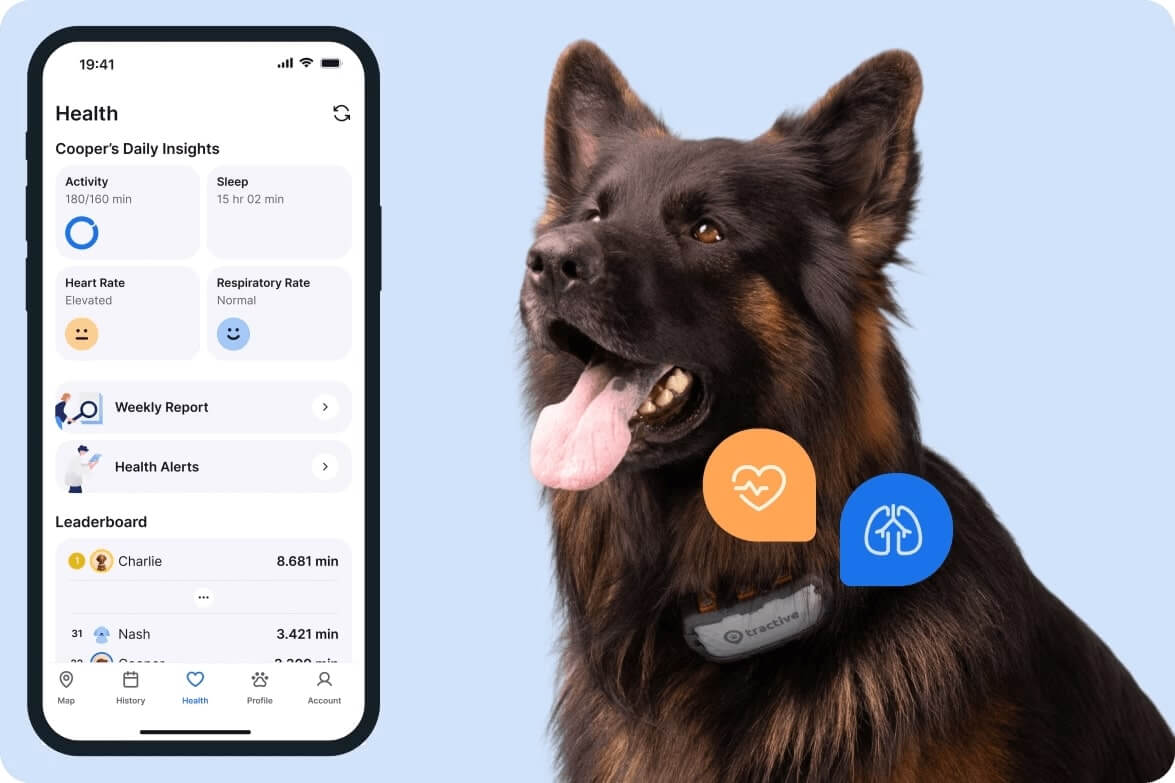What Do Dogs Dream About?
Turns out dogs and humans share similar brain patterns during sleep and dreams. Let's find out how.
Let’s admit, it’s both pretty endearing and also fascinating thinking of our furry friends in a happy doggy dreamland. So in this post, we’re going to dive into the world of canine dreams – what dogs dream about. (And how they’re not so different from us humans after all.)

Always know your buddy is healthy & safe
Read moreWhat do dogs dream about?
What they’ve been up to all day
Ever watched your napping dog move their paws or tail while asleep – as if they’re on a walk or running? They’re most likely dreaming about what they’ve been up to all day. Whether that’s chasing balls, playing fetch, or just bounding around your backyard. If your dog is more on the sociable side, they might be dreaming about playing with other dogs. Or spending time with their loved ones. Meaning you.
The people they love most
Yes, your dog likely dreams about you.2 Besides the zoomies, dogs might dream about the people they love most. So whether that’s walkies, cuddles, or playtime, you can bet your dog’s dreaming of enjoying them together with you.
Dogs also tend to be attuned to your emotions. They can sense your mood, respond to social cues, and show tremendous empathy. Because of this, they also have the ability to remember experiences, places, and people. So they’re most likely dreaming about you, your face, scent, and the places you’ve explored together. It’s how they strengthen their bond with you, their parent.
So take it from us and give your buddy some extra cuddle time today. You know they’ll be happily dreaming of it later.
Adventures they’d like to be on
Your dog has definitely chased a squirrel or two in their dreams. So their dreams might be full of the thrill of the chase or other exciting adventures. You’ll see this in the way they twitch and mimic running while fast asleep.
Besides dreams, your dog’s sleeping position says a lot about how they relate to you and their environment. For example, did you know that when a dog sleeps on their side, it shows they’re comfortable in their environment and trust you?

Get health alerts for your dog
Our pups can’t always tell us if something’s wrong. But if their tracker detects unusual changes in their routine, you’ll get an alert, helping you catch potential issues early.
Do dogs’ dreams make sense from a scientific viewpoint?
Yes, the science definitely backs it up. Evidence strongly suggests that dogs experience similar sleep and dream stages, just like humans. In fact, dog brains are built quite like human brains. So like we’ve covered, our brainwaves and brain activity tend to be quite similar during sleep.3 Here are a couple of the most recent findings on dogs and their ability to dream.
- Dogs experience REM sleep, like us.
Studies using electroencephalograms (EEGs) have monitored dog’s brains during sleep. They’ve found that dogs also exhibit rapid and irregular eye movements, muscle twitches, and increased brain activity – just like humans during REM sleep. From these findings, researchers have concluded that it’s definitely possible that dogs can dream.4 - Dogs show dream-like behaviors while asleep.
You might’ve observed your dog twitching, kicking, or even softly barking or growling while fast asleep. These movements, or dream-like behaviors, are akin to the actions they’d perform while awake. Like playing fetch in your yard or showing its dog park peers who’s boss. So just like you might dream about familiar activities or scenarios from your life, your dog might be reenacting experiences from their waking lives in their dreams. - Your dog’s ability to dream can depend on their size, age & build.
Smaller dogs and puppies tend to dream faster and more often – but with shorter dreams on average. On the other hand, larger dogs tend to have longer dreams as well as longer non-dream time. Older dogs and puppies are also more likely to dream than middle-aged dogs.5
Dogs tend to sleep better after exercise – just like us. Similarly, they’re more likely to get a longer, more peaceful sleep when on their own beds than elsewhere. (Also like us!) And unfortunately, like us, dogs can also have nightmares – about fighting with other dogs, thunderstorms, or loud, scary noises like fireworks.6
Can dogs have nightmares?
Much like humans, dogs can also have nightmares related to negative emotions or past traumatic events.7 If they’re whimpering or showing signs of distress while asleep, they might be having a bad dream. You might notice this in a newly-adopted dog or if your dog has just gone through a stressful or frightening experience. And with your Tractive sleep tracker, you can catch on to your dog’s sleep disturbances early on.
In some cases, your dog’s nightmares might be temporary. But make sure to check in with your local vet if they’re especially agitated at night or struggling to settle down for sleep.
How can I make sleep time easier for my dog?
You can create a comforting bedtime routine which helps your dog feel more secure. Dogs are creatures of habit – so regular sleep time can have a positive impact on their health and well being. For example, you could go for a long walk with your dog after your evening meal together. Start winding down for the day by slowly switching off the lights and electronics at home. Make sure they’re in a quiet, dark environment during sleep time – and leave them with a blanket that smells like you.
In case your dog is having difficulties falling asleep, we cover some ways you can get your dog to sleep through the night.
How can I soothe my dog when they have nightmares?
In these cases, it’s better to let them continue to sleep. Your dog firstly needs all the rest they can get to stay healthy. More importantly, waking them up might cause them to panic and bark out of instinct – or even scratch or bite you by accident. Instead, rather than waking them up physically, try and call your dog’s name softly. Give them plenty of cuddles if they come to you after. Your dog will sleep much better as a result of it – and their dreams might turn to you instead.
Read More: How To Manage The Sleep Startle Reflex In Dogs
How to monitor how well your dog is sleeping – with Tractive
Much like humans, a recurring pattern of disrupted sleep can indicate that your dog might not be doing too well, health-wise. In some cases, it might mean a medical problem – like an infection or sickness. So even though your dog might seem happy and healthy, they might be at risk of developing worse health problems with disturbed sleep. That’s where a Tractive smart dog tracker comes with Health Monitoring features to help you.

With its built-in motion detector, your trusty Tractive device helps you figure out:
- Your dog’s sleep quality and duration – including wakeups and disturbances,
- Your dog’s vital signs – i.e., their breathing and heart rate, including during sleep,
- Any weird change in either of these – in which case you’ll get a Health Alert prompting you to get them checked up at the vet.
This way, you can catch any dips and spikes early on – and get your dog to a vet in case you notice something wrong.
Now the next time you see your buddy wagging their tail or woofing softly while asleep, remember that they’re on their own little adventure in doggy dreamland. A place where they can relive their happiest moments with the ones they love the most. And with a little help from a dedicated pet tracker like the Tractive GPS, you can stay on top of your dog’s health and wellbeing – including how well they’re sleeping.



